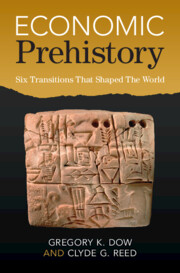Book contents
- Economic Prehistory
- Economic Prehistory
- Copyright page
- Dedication
- Contents
- Figures
- Tables
- Preface
- Acknowledgments
- Abbreviations
- Part I Prologue
- 1 Economics Meets Archaeology
- 2 A Primer on Malthusian Economics
- Part II Sedentism and Agriculture
- Part III Inequality and Warfare
- Part IV Cities and States
- Part V Epilogue
- References
- Author Index (Abridged)
- Subject Index
1 - Economics Meets Archaeology
from Part I - Prologue
Published online by Cambridge University Press: 10 February 2023
- Economic Prehistory
- Economic Prehistory
- Copyright page
- Dedication
- Contents
- Figures
- Tables
- Preface
- Acknowledgments
- Abbreviations
- Part I Prologue
- 1 Economics Meets Archaeology
- 2 A Primer on Malthusian Economics
- Part II Sedentism and Agriculture
- Part III Inequality and Warfare
- Part IV Cities and States
- Part V Epilogue
- References
- Author Index (Abridged)
- Subject Index
Summary
Prehistory refers to the period before written documents. Evidence about the events of prehistory is obtained from archaeology, and from anthropological research on small-scale societies of the recent past. For the vast majority of human existence, people lived in small mobile foraging bands. In the trajectory that ultimately led to large-scale societies, six crucial transformations stand out: the transitions to sedentism, agriculture, inequality, warfare, cities, and states. We suggest that economic theory can be used to explore the causal factors behind these transitions. We sketch the nature of the evidence available from archaeology and outline basic economic ideas for non-economists. Our general method in studying a particular type of transition is to review well-documented regional cases from archaeology, together with other relevant empirical generalizations, and then construct a formal economic model to account for this body of evidence. After deriving predictions from our model, we often discuss further regional cases that were not used in the construction of the original model. We will preview the conclusions reached in subsequent chapters, briefly survey the economic literature on prehistory, and compare our framework to the theoretical frameworks used by archaeologists and other scholars.
Keywords
- Type
- Chapter
- Information
- Economic PrehistorySix Transitions That Shaped The World, pp. 3 - 49Publisher: Cambridge University PressPrint publication year: 2023

